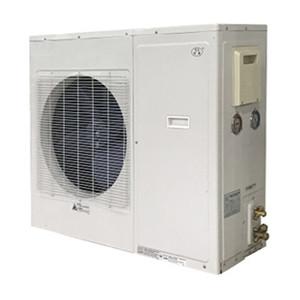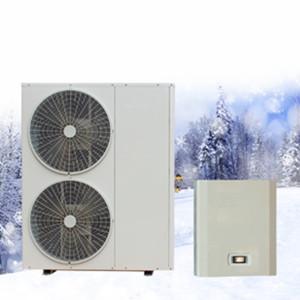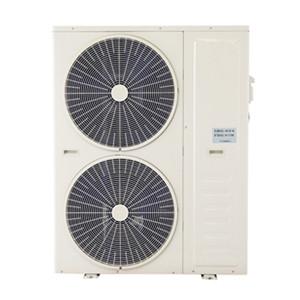Air source heat pump problems in cold weather
Heat pumps are some of the best and most cost-effective alternatives to
traditional heating methods. Since the amount of carbon emissions produced is
greatly reduced, it can heat houses and/or water in a greener way. However, you
may have noticed that warmer weather may be better for heat pump systems, and
colder temperatures may reduce its efficiency. In order to make full use of the
heat pump in winter, you need to keep in mind some precautions, which we will
introduce step by step in this article.
How does the air source heat pump work?
The heat pump uses the air or the heat around the air as the main energy
source.
The air source heat pump itself includes a fan that rotates to introduce
outside air and is installed outdoors. After the fan enters the air, the
heating process begins:
Outdoor air passes through an exchanger coil containing refrigerant
fluid
. The refrigerant fluid boils and evaporates, turning into vapor
. Steam is compressed at high temperature to generate heat
Why can a heat pump work in a low temperature environment?
Thanks for the environmentally friendly R407C/R410A refrigerant. Even at
an extremely low temperature of -20°C, R407C/R410A refrigerant can absorb heat,
which is why heat pumps can work in cold climates.
Which heat pump is best for cold weather?
The best cold weather heat pump is a ground source (geothermal) heat
pump. It is considered the best way to use it because it is buried in the
ground and provides heat naturally and continuously. Because the pipeline is
buried at the proper depth, it cannot be reached by frost and cold
weather-therefore, the natural warmth provided by the ground prevents the
pipeline from freezing.
Why does air source heat pump reduce efficiency in cold weather?
The amount of heat that an air source heat pump can deliver to you
depends largely on the outdoor temperature. As the outside temperature drops,
the total heat of the air source heat pump also drops.
As the external temperature decreases, the heating capacity of the air
source heat pump also tends to decrease. The size of the air source heat pump
is usually able to generate 80-90% of the annual load, and when the temperature
is higher than the freezing point, it should be able to meet 100% of the
heating requirements of your home.
Therefore, it is recommended that you have a backup heating source when
the outdoor temperature drops. In this way, when the efficiency of the air
source heat pump starts to drop, it can compensate for the slack.
Heat pump problems in winter
1. Refrigeration without heating
The air source heat pump has two functions: cooling and heating.
If you turn on the heat pump in winter without heating effect, the first
thing to check is that the air source heat pump is not in the "cold"
setting. If this is not the case, the refrigerant liquid circulating around the
pipe may leak. In this case, engineers will be required to repair the leak.
2. Heating bills are rising
1) In winter, the heat pump is likely to need to use the defrost mode,
which means that your electric energy is used to achieve the two functions of
defrosting and heating. In summer, only one function is needed for heating.
2) The temperature in winter is low, and the heat pump needs to consume
more electricity than in summer to absorb enough heat to heat hot water for
your home.
Heat pumps consume more electricity in winter, and electricity bills
will inevitably rise
3. The heat pump freezes
The weather is cold in winter. The heat pump may be frozen. This is why
the heat pump must have a defrost function in winter. And the pipes of the heat
pump must be antifreeze treatment. If the temperature is too low, the pipe will
freeze on its own.
How to use heat pump in winter:
Although it may feel cold in winter, the air source heat pump can still
use it to generate heat for the property's central heating system.
These 7 tips will help you make the most of air source heat pumps in
winter.
1. Don't cover the heat pump
Covering the heat pump to prevent the heat pump from freezing but
covering the air source heat pump, the airflow is blocked, which will reduce
efficiency and may even cause mold.
2. Get a smart thermostat
Smart thermostats are a valuable addition to any central heating system,
not only heat pumps. He will greatly improve the efficiency of heat
utilization.
3. Remove leaves, snow and other debris
Leaves, snow or other debris will block the airflow of the heat pump,
and the efficiency of the heat pump will begin to decline. Therefore, it is
important to clean as much of the area around the heat pump as possible.
4. Make sure your house is well insulated
Good house insulation will effectively retain heat. reduce waste.
5. Switch to a cheaper energy supplier
Air source heat pumps require electricity to function. You can use solar
energy to generate electricity.
6.Consider a larger radiator
A radiator with a larger surface area or floor heating is the best
radiator.
7. Check the heat pump before winter
In winter, you can check the air source heat pump yourself or ask a
professional to ensure the efficient operation of the heat pump.
Free heat pump quote
Leomon Technology has the most competitive price, come get your free quotation for the heat pumps.






